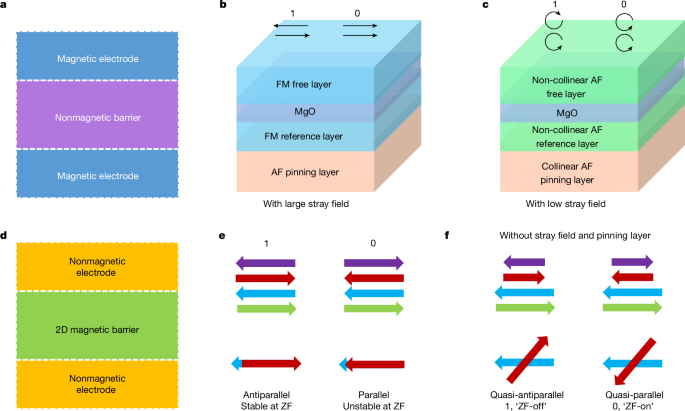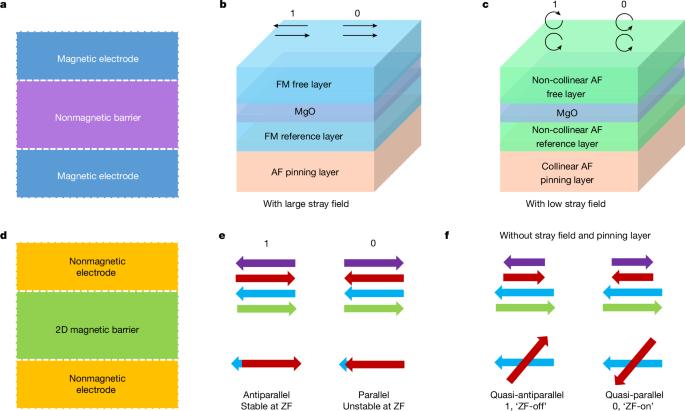Twist-assisted all-antiferromagnetic tunnel junction in the atomic limit
IF 48.5
1区 综合性期刊
Q1 MULTIDISCIPLINARY SCIENCES
引用次数: 0
Abstract
Antiferromagnetic spintronics1,2 shows great potential for high-density and ultrafast information devices. Magnetic tunnel junctions (MTJs), a key spintronic memory component that are typically formed from ferromagnetic materials, have seen rapid developments very recently using antiferromagnetic materials3,4. Here we demonstrate a twisting strategy for constructing all-antiferromagnetic tunnel junctions down to the atomic limit. By twisting two bilayers of CrSBr, a 2D antiferromagnet (AFM), a more than 700% nonvolatile tunnelling magnetoresistance (TMR) ratio is shown at zero field (ZF) with the entire twisted stack acting as the tunnel barrier. This is determined by twisting two CrSBr monolayers for which the TMR is shown to be derived from accumulative coherent tunnelling across the individual CrSBr monolayers. The dependence of the TMR on the twist angle is calculated from the electron-parallel momentum-dependent decay across the twisted monolayers. This is in excellent agreement with our experiments that consider twist angles that vary from 0° to 90°. Moreover, we also find that the temperature dependence of the TMR is, surprisingly, much weaker for the twisted as compared with the untwisted junctions, making the twisted junctions even more attractive for applications. Our work shows that it is possible to push nonvolatile magnetic information storage to the atomically thin limit. By twisting two bilayers of CrSBr, which is a 2D antiferromagnet, a >700% nonvolatile tunnelling magnetoresistance at zero field is shown, demonstrating a new strategy for constructing all-antiferromagnetic tunnel junctions down to the atomic limit.


原子极限的扭转辅助全反铁磁隧道结。
反铁磁自旋电子学1,2 在高密度和超快信息设备方面显示出巨大潜力。磁隧道结(MTJ)是一种关键的自旋电子存储器件,通常由铁磁材料形成,而最近利用反铁磁材料3,4 实现了快速发展。在此,我们展示了一种扭转策略,用于构建低至原子极限的全反铁磁隧道结。通过扭转两层二维反铁磁体(AFM)CrSBr,在零磁场(ZF)下显示出超过 700% 的非挥发性隧穿磁阻(TMR)比,整个扭转叠层充当隧道势垒。这是由两个 CrSBr 单层的扭转决定的,其 TMR 来自于单个 CrSBr 单层之间的累积相干隧穿。TMR 与扭转角度的关系是通过电子在扭转单层上的平行动量衰减计算出来的。这与我们考虑 0° 至 90° 扭转角的实验结果非常吻合。此外,我们还发现,与非扭曲结相比,扭曲结的 TMR 与温度的相关性要弱得多,这让扭曲结在应用中更具吸引力。我们的工作表明,将非易失性磁信息存储推向原子薄极限是有可能的。
本文章由计算机程序翻译,如有差异,请以英文原文为准。
求助全文
约1分钟内获得全文
求助全文
来源期刊

Nature
综合性期刊-综合性期刊
CiteScore
90.00
自引率
1.20%
发文量
3652
审稿时长
3 months
期刊介绍:
Nature is a prestigious international journal that publishes peer-reviewed research in various scientific and technological fields. The selection of articles is based on criteria such as originality, importance, interdisciplinary relevance, timeliness, accessibility, elegance, and surprising conclusions. In addition to showcasing significant scientific advances, Nature delivers rapid, authoritative, insightful news, and interpretation of current and upcoming trends impacting science, scientists, and the broader public. The journal serves a dual purpose: firstly, to promptly share noteworthy scientific advances and foster discussions among scientists, and secondly, to ensure the swift dissemination of scientific results globally, emphasizing their significance for knowledge, culture, and daily life.
 求助内容:
求助内容: 应助结果提醒方式:
应助结果提醒方式:


